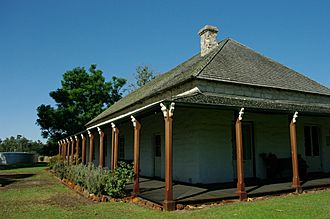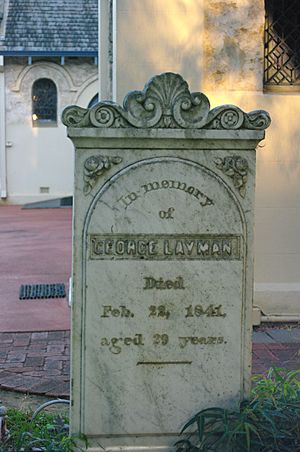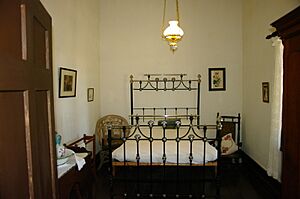Wonnerup House facts for kids
Quick facts for kids Wonnerup House |
|
|---|---|

Wonnerup House
|
|
| General information | |
| Type | Farm |
| Location | Wonnerup, Western Australia |
| Coordinates | 33°37′39″S 115°25′58″E / 33.6276°S 115.4328°E |
| Designated | 13 August 2014 |
| Reference no. | 424 |
Wonnerup House is a special old farm in Wonnerup, Western Australia. It's a place with a lot of history! The main house you see today was built in 1859. It was built by George Layman Jr. His father, George Layman Sr., built the first house in 1837, but it burned down. Luckily, the dairy and kitchen buildings were separate and survived the fire.
Later, stables and a blacksmith workshop were added to the farm. In the 1870s, George Layman Jr. gave land for a school. This school was built in 1873, and a teacher's house followed in 1885. The whole farm area was bought by the National Trust of Australia in 1971. It opened to visitors in 1973, so people can learn about its past.
The name Wonnerup comes from the Nyungar language. "Wanna" means a woman's digging stick, and "up" means water.
Contents
The Layman Family's Journey

George Layman Sr. was 17 when he moved to Australia from England in 1827. He first settled in Tasmania. In 1829, he decided to move to the new Swan River Colony in Western Australia. He arrived there in October 1829.
In 1832, George married Mary Ann Bayliss in Perth. They started a home in Augusta. But Augusta wasn't a good place for a settlement. So, many families, including the Laymans, moved to the Vasse region.
George and Mary Layman moved to Vasse in 1834. They had two young daughters, Harriet and Mary. Their son, George Jr., was born in 1837. That same year, George Sr. built their first home. He also built a separate dairy and kitchen with a cellar and big ovens. The Laymans had two more children: Charles (born 1838) and Catherine (born 1841).
Life was sometimes difficult between the European settlers and the local Wardandi people. In February 1841, George Layman Sr. died in an incident. After his death, his wife Mary married Robert Heppingstone. They had two children, Arthur and Robert. Robert Heppingstone managed the Wonnerup farm. He also ran a whaling business. Sadly, in September 1858, Robert Heppingstone drowned in an accident while working with his whaling boat.
Earlier that year, in February 1858, the Layman family's first house burned down. Only the separate dairy and kitchen buildings were saved.
Building the Current Wonnerup House
After his stepfather's death and the house fire, 20-year-old George Layman Jr. took over the farm. In July 1859, George Jr. married Amelia Harriet Curtis. They started building the new Wonnerup House. This is the house that stands today.
The house was built using local limestone and timber. The original wooden roof shingles were later covered with corrugated iron.
How the House Grew
The house was built in different stages. It started with four rooms and a hall. A kitchen and scullery were added around 1862. In 1925, a bathroom and toilet were built. The kitchen and dairy, which survived the fire, were expanded in 1872. By the 1880s and 1890s, Wonnerup House was a very successful dairy farm in the area.
The main gates of the farm are made of cast iron. They are set on limestone columns. These gates were put up to remember George Layman Sr. A special plaque on the columns tells his story: "George Layman came to Western Australia in 1829 aged 18 years, Augusta 1830, Wonnerup 1834, speared by natives 1841".
The Farm Land and Its Legacy
The land where Wonnerup House is located was first bought by George Layman Sr. He started with about 500 acres (200 hectares). Over time, the Layman family bought more land next to it. At its biggest, the farm covered over 2,500 acres (1,000 hectares).
George Layman Jr. passed the farm management to his youngest son, James, in the 1900s. After James died in 1911, his parents and four unmarried sisters managed the farm. Later, a nephew took over. In 1962, after the last Layman sister passed away, the farm was sold. The land was divided up.
The part of the land with Wonnerup House and its buildings was bought by the National Trust of Australia in 1971. This purchase included furniture, personal items, and Aboriginal artifacts collected by the Layman family since 1829. In 1973, the National Trust opened Wonnerup House to the public. The Western Australian Government also gave the old school house and teacher's residence to the National Trust.
The School and Teacher's House
Across the road from Wonnerup House, you can see the old school building (built 1873) and the teacher's house (built 1885). These were built on land that George Layman Jr. gave to the government.


